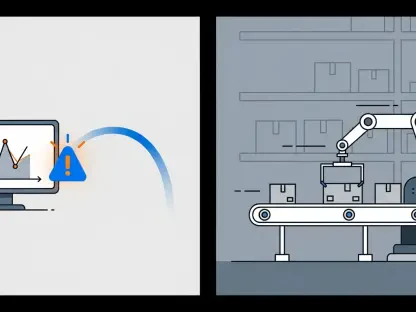The advent of robotic process automation (RPA) is gradually reshaping the landscape of the accounting industry, unveiling numerous opportunities to enhance efficiency, accuracy, and overall productivity. This technology uses software robots to mimic human actions, automating repetitive, mundane tasks that often consume significant time and resources. For accounting firms grappling with increasing client demands and a rapidly evolving regulatory environment, RPA offers a strategic tool to alleviate these pressures. By automating routine processes, accountants can focus their expertise on higher-value tasks that require critical thinking and professional judgment, ultimately driving better financial outcomes for their clients and their firms. As we delve deeper into how RPA can specifically revolutionize accounting tasks, we’ll explore its fundamental principles, distinctions from artificial intelligence (AI), various applications within the accounting field, and practical steps for successful implementation.
Understanding Robotic Process Automation (RPA) and Its Impact
At its core, robotic process automation is designed to take over highly repetitive, rule-based tasks that do not require human cognition. RPA software can log into applications, enter and process data, perform calculations, and communicate with other digital systems, mimicking the actions human workers would typically undertake. One of the key benefits of RPA is its ability to work with existing systems, requiring minimal changes to the underlying IT infrastructure. This makes it an attractive option for firms with legacy systems that do not support modern APIs or other advanced integrations.
The impact of RPA on the accounting sector is profound. Traditional accounting tasks, such as data entry, reconciliation, invoice processing, and report generation, are inherently repetitive and prone to human error. By delegating these tasks to RPA, firms can expect increased accuracy and consistency in their operations. Moreover, RPA can operate around the clock, drastically reducing the time required to complete business processes. This not only improves operational efficiency but also enhances the overall client experience, as clients benefit from faster service delivery and more reliable financial reports.
RPA vs. AI: Complementary Technologies for Optimal Efficiency
While RPA and AI are often mentioned together in discussions about automation, it is essential to understand their distinct roles and how they complement each other. RPA is fundamentally process-driven, executing tasks based on predefined rules and instructions. It does not have the capability to learn or adapt beyond its programming. AI, on the other hand, is data-driven and simulates human intelligence. It can recognize patterns, understand unstructured data, and improve its performance over time through machine learning algorithms.
The complementary nature of RPA and AI can significantly amplify their individual benefits. For instance, AI can analyze vast datasets to identify trends and generate insights that would be impossible for humans to detect manually. When these insights are coupled with RPA, the actionable outcomes can be implemented automatically, ensuring rapid and consistent application of data-driven decisions. Conversely, RPA can handle the mundane tasks that form the foundation of AI’s data inputs. This synergy not only enhances the capabilities of both technologies but also enables firms to automate complex, end-to-end processes that span multiple functions and systems.
Practical Applications of RPA in Accounting
The potential applications of RPA in accounting are vast, covering a wide range of tasks from data entry to tax compliance. In bookkeeping, RPA can automatically import transaction data from various sources, categorize expenses, and reconcile accounts with minimal human intervention. This can drastically reduce the time spent on month-end closing activities and improve the accuracy of financial records. Similarly, in invoicing, RPA can generate, send, and follow up on invoices, ensuring timely payment and reducing the risk of errors and disputes.
Tax compliance is another area where RPA can provide significant benefits. By automating the collection and processing of tax-related data, RPA can help ensure that filings are accurate and timely, thus reducing the likelihood of penalties and audits. In the realm of payroll, RPA can streamline the processing of employee wages, tax withholdings, and benefits administration, ensuring compliance with local laws and regulations while freeing up HR personnel to focus on strategic initiatives. Expense management also stands to gain from RPA, as it can automate the submission, approval, and reimbursement of employee expenses, providing real-time tracking and reporting capabilities.
Implementing RPA: Strategies and Best Practices
Implementing RPA within an accounting firm requires careful planning and consideration to maximize its benefits and ensure a smooth transition. The first step is to identify the pain points and repetitive tasks that are most suitable for automation. Conducting a thorough analysis of existing processes can reveal which activities are most time-consuming and error-prone, providing a roadmap for RPA implementation.
Once the target processes have been identified, the next step is to assess the available RPA tools and determine which ones best meet the firm’s needs. No-code and low-code RPA solutions can greatly simplify this phase, as they require minimal programming knowledge and offer pre-built components that can be easily configured through visual interfaces. It is also crucial to consider the budget and resources available for the implementation, as well as any training or third-party assistance that may be required.
Combining RPA with AI should be a strategic goal to maximize efficiency. By leveraging AI’s analytical capabilities, firms can identify new opportunities for automation and continuously improve their processes. It is also essential to monitor and maintain RPA systems regularly, ensuring that they remain up-to-date and aligned with the firm’s evolving needs and regulatory requirements.
The Future of Accounting with RPA
Looking ahead, the adoption of robotic process automation in accounting is poised to accelerate as firms recognize its transformative potential. The shift towards automation is not merely about replacing human labor; it is about augmenting human capabilities and allowing accountants to focus on more strategic, value-added activities. This evolution is expected to drive greater innovation within the industry, fostering a culture of continuous improvement and operational excellence.
Moreover, the integration of RPA with other emerging technologies, such as blockchain and advanced data analytics, holds promise for even more profound changes. Blockchain’s secure and transparent ledger system can complement RPA by ensuring the integrity of automated transactions, while data analytics can provide deeper insights into financial performance and risk management.
Conclusion
Robotic process automation has revolutionized the accounting industry by automating repetitive tasks, enhancing accuracy, and improving efficiency. The distinction between RPA and AI, and their complementary nature, creates significant opportunities for accounting firms to optimize their operations. Practical applications of RPA in accounting range from bookkeeping and invoicing to tax compliance and payroll, offering substantial time and cost savings. Implementing RPA requires careful planning and consideration, but the benefits far outweigh the challenges. The future of accounting looks promising with the continued adoption of RPA and its integration with other emerging technologies. As firms embrace this technology, they will be better positioned to meet evolving client demands and stay competitive in a rapidly changing industry landscape. The journey toward automation ultimately drives better financial outcomes, operational excellence, and a heightened focus on strategic, high-value tasks.









